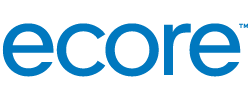This CE Center article is no longer eligible for receiving credits.
Who would have thought a pandemic would lead to a surge in health and wellness concerns, and a booming fitness and wellness market? But that is what is happening. As a result, spending on fitness and sports equipment, clothing, and other goods is rising and will continue to climb.
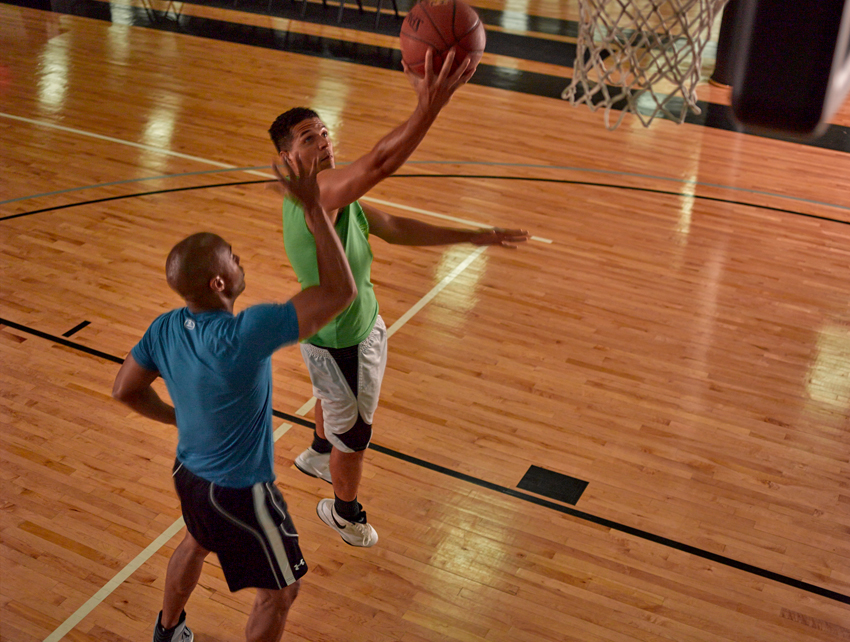
All images courtesy of Ecore
High-performance athletic flooring can provide safety, ergonomic, and acoustic benefits.
Research shows that the increase in these markets is being driven by two factors.1 First, the COVID-19 pandemic has highlighted the importance of personal health and fitness in fighting off this and possibly future viruses. And the second driving force is what one researcher called “constant improvements in materials used for manufacturing” of sports-related equipment. An example is the growing prevalence of sensors in equipment that indicate to athletes how they are performing. Advancements in materials mean quicker adoption of new products.
Together, these factors result in an increasing need for new and remodeled sports, fitness, and recreation facilities. And special consideration should be given to the foundation of all these spaces: the flooring.
In sports, fitness, and recreation applications, one size does not fit all when it comes to flooring. Athletic flooring must do more than look good at a good price point. These surfaces should enhance performance and protect athletes and fitness enthusiasts. Engineered performance surfaces can provide safety, ergonomic, and acoustic benefits. This course identifies the needs in sports, fitness, and recreation applications, and then guides architects, designers, and specifiers toward the best performance surfacing to select.
Needs of Sports Athletes
Being the best is never easy. Natural talent counts for a lot, but the truly elite hit the training center with consistent determination and grit. Sports flooring and surfaces should likewise promote consistency. The designer or specifier should ask: Can a floor support the athlete? The answer is yes. A floor can reward those who train the hardest.
Think about it: Athletes and coaches agonize over choosing shoes that will support them and help them perform their best. So, shouldn’t the floor they train on do the same thing? When an athlete attempts to beat his or her fastest time or lift more weight than ever before, a shock-absorbent, slip-resistant floor lets him or her train for peak performance while lowering the risk of injury.
This applies also to children in sports. In 2013, according to the nonprofit organization Safe Kids, more than 1.24 million children ages 19 and under were seen in emergency departments in the United States for injuries related to 14 commonly played sports.2 In fact, unintentional falls are the leading cause of non-fatal injuries for children in the United States.3
Performance flooring requirements for sports include:
- Force reduction (how much energy a surface absorbs);
- Energy restitution (how much energy a surface returns);
- Ball rebound for courts;
- Slide effect; and
- Playability.
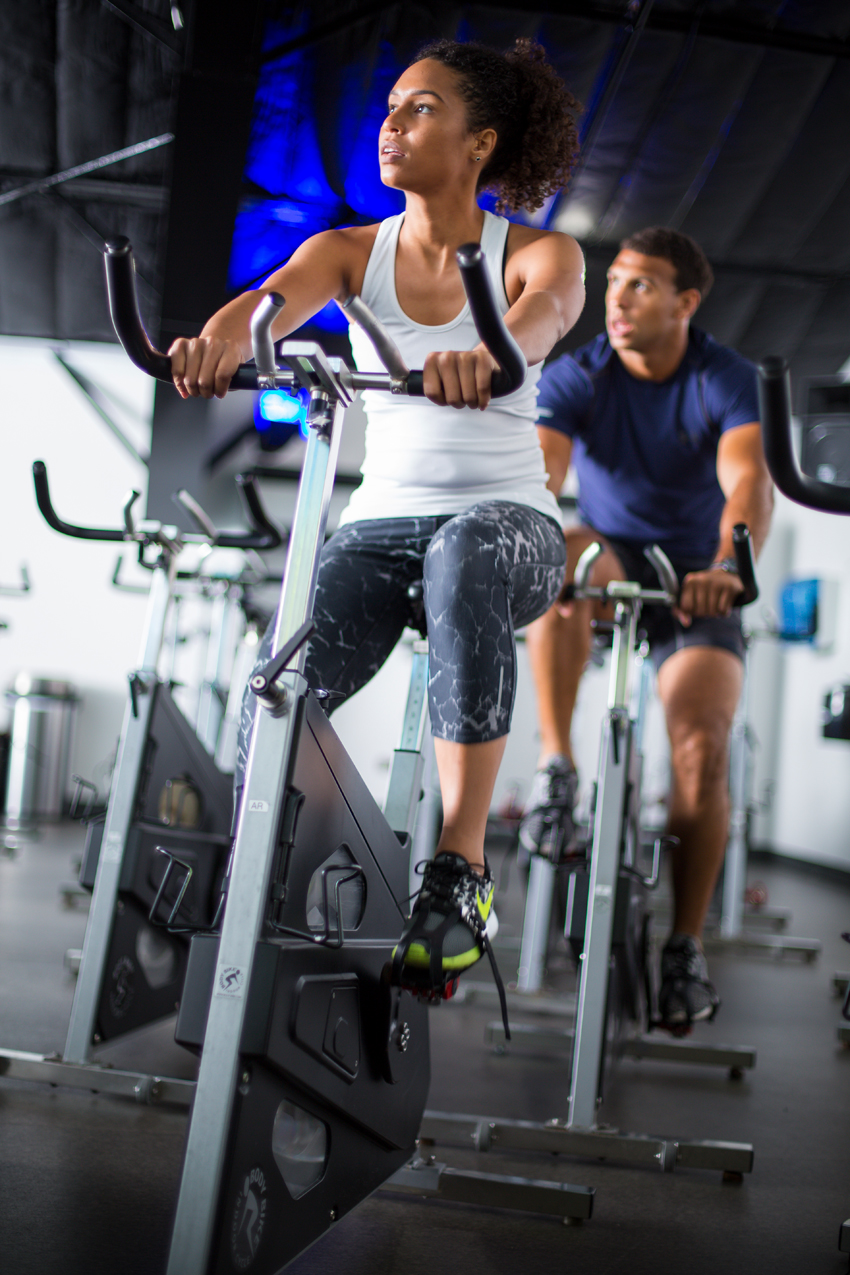
The COVID-19 pandemic showed the importance of physical fitness for fighting off both this and future viruses. As a result, the fitness industry is booming.
Needs of Fitness Enthusiasts
Fitness equipment is a multibillion-dollar industry. Gym-goers spend time and money choosing the right yoga mat, the right clothing, and the best cardio equipment. So, when they get to the gym, the fitness room flooring should likewise support their fitness goals. No one should have to worry about falling or suffer from an injury due to repetitive impact on a floor that is unforgiving. A gym surface should provide an enjoyable, comfortable space to work out.
Performance flooring requirements for fitness include:
- Force reduction and energy restitution for users;
- Multipurpose function for flexibility of use;
- Special consideration if tap shoes will be used for dance space;
- Mitigation of noise transmission from weight drops and cardio machines;
- Slip-resistance with high coefficient of friction (both wet and dry);
- Energy restitution to mitigate indentation; and
- Sound and vibration considerations for rooftop fitness areas.
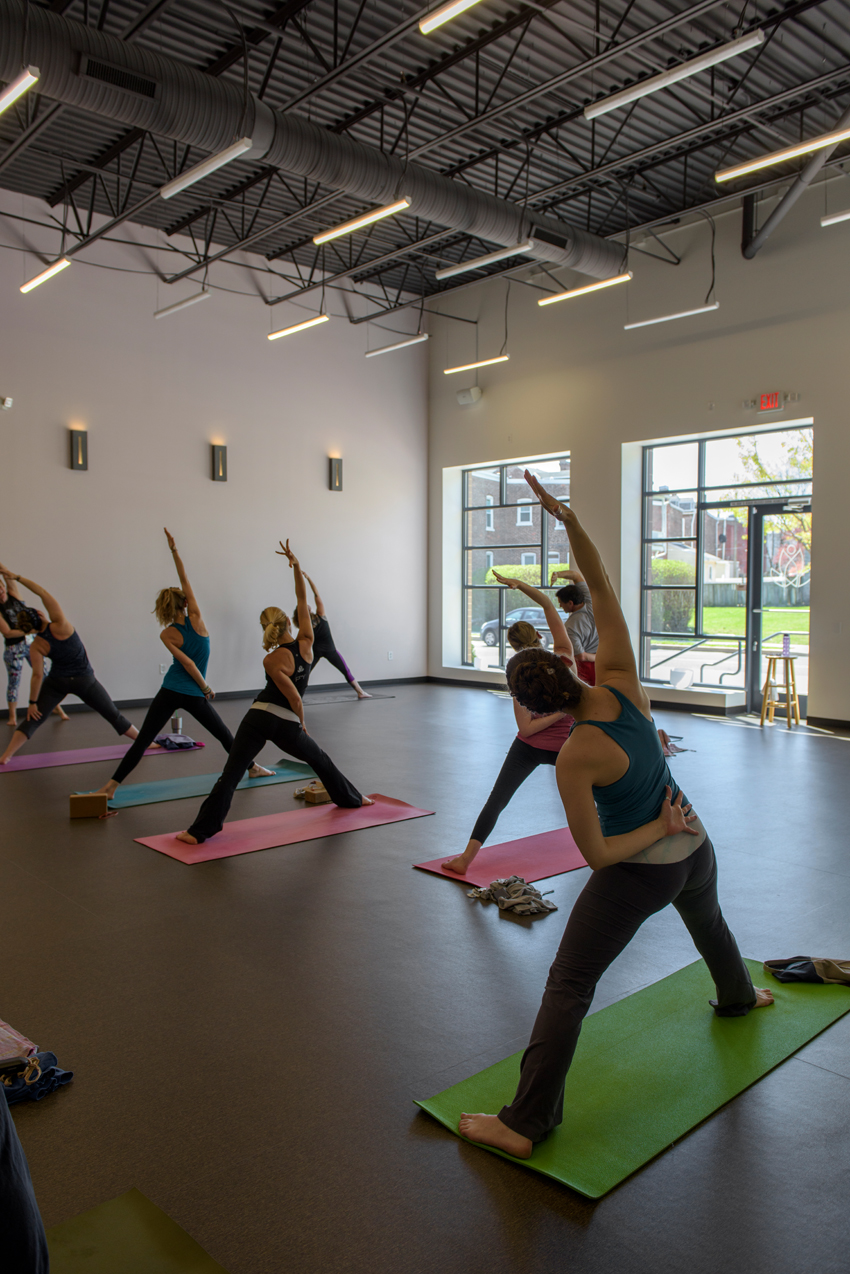
The right performance flooring specification can help create a recreation center that is heavily used by the community.
Needs of Recreation Center Users
A recreation center is more than a building. It is a space to build health, wellness, engagement, and community for both users and staff. This is why selecting the right recreation floor is critical when building or renovating a recreation facility.
In a recreation center, excess noise and impact vibrations can cause fatigue, headaches, and bad moods for staff and users. High levels of noise in a community or school recreation center could cause a decrease in usage, which is the opposite of the intended effect. Performance surfaces are engineered to help reduce sound and vibration, which is needed for busy, multiuse facilities. Whether there is a need to reduce noise for neighbors or to create a restorative space where users can practice mindfulness, performance flooring in a recreation center can help achieve these goals.
Performance flooring requirements for recreation include:
- Force reduction and energy restitution for staff and users;
- Shock absorption for falls; and
- Enhanced traction for wet areas.
Acoustics, Ergonomics, and Safety Are Paramount
Whether specifying a surface for a sports, fitness or recreation application, there are three essential benefits that all performance surfaces should provide: safety, ergonomics, and acoustics.
Acoustic Considerations
The acoustic issues found in typical athletic facilities stem from the nature of a building’s construction and the specified materials or surfaces. Many facilities feature large, open spaces dominated by hard walls and ceilings that reflect sound. Due to the expansiveness of these spaces, many facilities cannot afford to install new flooring everywhere, so concrete is ever present. This combined with the reflective materials, such as concrete, metal, brick, and plasterboard, used on parallel walls and ceilings makes these spaces very loud.
As such, it is important to isolate or dampen sound as much as possible throughout an athletic, fitness, or recreation facility. Types of sounds to consider isolating include:
- Weights dropping or hitting each other;
- Cardio machines;
- Footsteps or pounding;
- Exercise class music; and
- Structural sounds (HVAC systems, pipes, motors, generators, etc.).
Many of these sounds can travel quickly and create unwanted noise in other spaces within a building by sending vibrations through pipes, frames, ductwork, ceilings, or electrical junctions. To isolate the sounds within an enclosed space and dampen their impact, absorptive materials must be used to shorten or eliminate reverberation, while irregular surfaces should be arranged to reflect sound in different directions.
Impact sound: The energy of a falling object depends on its mass and how far it falls. The falling objects could be footfall on a treadmill, someone jumping off a box, or a dropped dumbbell. Engineered flooring products are designed to manage this energy. The best products to use, and the ways they are tested, depend upon the amount of energy being released and how it should be managed. The energy created from the impact has two general transmission paths, which are:
- In-room impact noise: The sound level in the room where the impact occurs.
- Transmitted impact noise: The sound level in the adjacent room.
Transmitted impact noise: Transmitted impact noise is typically measured in the room below where the impact occurs. The tests most commonly referred to for impact noise are the impact insulation class (IIC) and the delta impact insulation class (∆IIC). These tests only address the impact sound transmission to the room below the impact. In addition, the tests are designed to address footfall noise and include the entire floor/ceiling structure, not just the flooring or underlayment.
Acoustics ratings are also important for choosing flooring. However, the specifier should understand the difference between residential and fitness needs.
IIC ratings are a helpful reference for residences and other uses where footsteps are the primary concern for impact sound, but IIC ratings do not apply to noise from heavy weight impacts in gyms. The tapping machine used in IIC and ∆IIC tests has 1.1-pound weights dropped from 1.6 inches. These impacts are not enough to represent the energy from 35-pound dumbbells and kettlebells dropped from 1–2 feet, or 250-pound barbells dropped from 5–6 feet.
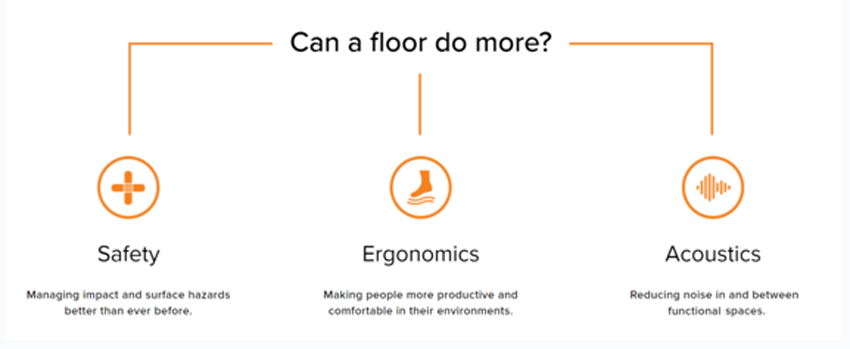
A true performance surface provides safety, ergonomic, and acoustic benefits to the people using the surface.
Acoustic Terms and Standards
Impact insulation class (IIC): ASTM E492: Standard Test Method for Laboratory Measurement of Sound Transmission Through Floor-Ceiling Assemblies Using the Tapping Machine measures the reduction of impact noise provided by a floor-ceiling assembly.
Delta IIC (∆IIC): ASTM E2179: Standard Test Method for Laboratory Measurement of the Effectiveness of Floor Coverings in Reducing Impact Sound Transmission Through Concrete Floors measures the improvement from adding the flooring and/or underlayment to a bare concrete slab. It gives a more precise idea of what a product might add to a floor-ceiling assembly.
Sound transmission class (STC): ASTM E90: Standard Test Method for Laboratory Measurement of Airborne Sound Transmission Loss of Building Partitions and Elements. Higher values are better as they indicate less transmission of airborne sound. STC is generally not affected significantly by floor coverings and underlayments.
Surface-generated noise: ASTM E3133: Standard Test Method for Laboratory Measurement of Floor Impact Sound Radiation Using the Tapping Machine measures the sound from an impact in the room where the impact occurs. It can be used to evaluate flooring’s ability to reduce noise from footfalls, rolling carts, etc.
Ergonomic Considerations
There are important aspects to consider with regard to both force reduction and energy restitution.
Force reduction and energy restitution: Force reduction is how much energy a surface absorbs. Energy restitution is how much energy a surface returns.
Force reduction adds a level of safety, while energy restitution adds performance and durability. For example, concrete is hard, and it has very low force reduction (-1.9 percent) but high energy restitution (77.2 percent). The result: Concrete returns a lot of energy, which can be tough on an athlete’s joints.
On the opposite end of the spectrum is sand, which has a lot of give. Sand has a very high force reduction (82.7 percent) and low energy restitution (0.5 percent). There is almost no energy being returned here, so it is much more difficult to walk on, since sand is soft and “giving” as you walk.
Every sports, fitness and recreation application requires a performance floor that provides the right balance of energy restitution and force reduction. For example, in applications where heavy weights are being dropped, durability is key, thus requiring a product with higher energy restitution. This type of space demands that a surface is durable enough to withstand the constant drop of weights. For an indoor track, however, some force reduction is necessary to lessen the impact on joints while energy restitution returns energy to keep the athlete going. For applications that are a mix of strength and conditioning or a multipurpose space, an even amount of force reduction and energy restitution is ideal.
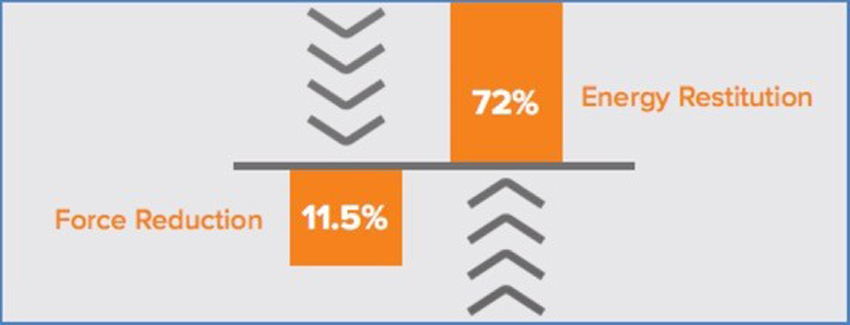
Force reduction indicates how much energy a surface absorbs. Energy restitution, on the other hand, indicates how much energy a surface returns.
Safety Considerations
Slip resistance: Slip-resistant flooring should be used in areas that require an extra measure of safety. Vulcanized composition rubber floors are slip resistant whether wet or dry. Embossed surfaces provide slip-retardant performance. Slip resistance can be measured by the coefficient of friction. It is also a good idea to consider colors and patterns that hide the appearance of scuffs, scratches, and abrasion.
Sports Surface Testing Standards
Sports surface testing standards are critical to determine if the surface will perform according to needs specific to sports applications, such as ball bounce, shock absorption, and other factors. The following standard is used to evaluate the performance of sports flooring:
ASTM F2772: Based on Four Criteria
ASTM F2772: Standard Specification for Athletic Performance Properties of Indoor Sports Floor Systems is the testing method for indoor sports flooring.
To meet the ASTM F2772 standard, sports floors are evaluated on four criteria—force reduction (shock absorption), vertical deformation, ball rebound, and coefficient of friction (surface finish effect)—and then classified into one of five performance-level classifications (from Class 1 to Class V). These are the four criteria:
Force reduction (ASTM F2569): The first factor is force reduction, and this portion of the ASTM F2772 standard is tested in accordance with ASTM F2569. A surface’s force reduction is measured as a percentage of how much of the total force of an impact is reduced by the surface on which the object in motion, such as a foot, dumbbell, head, or other part of the body, falls. Per ASTM F2659, a surface’s force reduction may be an “indicator of its performance, safety, comfort, or suitability of the surface.” The more force that a surface reduces, the less chance of injury when an athlete falls on the floor because a percentage of the impact’s shock is being absorbed by the floor.
Vertical deformation (ASTM F2157): Vertical deformation measures the elasticity of a surface under an athlete’s foot or a heavy load. The amount that a surface deflects or “gives” under an athlete’s foot or under a table, chair, or other heavy load can contribute to creating a safer floor that reduces injuries. On the other hand, a surface that gives too much or is too elastic will result in an unstable surface that may contribute to causing injuries.
Ball rebound (ASTM F2117): The way a ball interacts with the playing surface can dramatically affect how a game is played, so it is important that the sports floor does not affect a ball’s ability to bounce. For example, if a basketball game is being played on a synthetic sports floor, the ball should bounce back similarly to how it would on a hardwood basketball court.
The ball rebound portion of the ASTM F2772 test standard is measured in accordance with ASTM F2117. It is calculated by taking the difference in bounce height, when a ball is bounced on the sports floor, compared to concrete. The average of multiple drop points on the floor must meet or exceed 90 percent of the rebound height of a ball dropped on concrete. Any one test point cannot differ by more than 3 percent from the average rebound height. This requirement is to ensure that the sports surface performs uniformly throughout the court.
Surface finish effect (ASTM E303): The surface finish effect portion of the ASTM F2772 test standard measures a surface’s frictional properties. Also known as “slide effect,” this portion of the standard is important to ensure the surface provides the optimal level of traction for an athlete. When athletes are competing, it is important that the floor is not too slippery so that they can change directions and eliminate the worry of falling. However, it is also equally important that the floor does not have too much “grab” because this can increase the risk of injuries.

Athletic flooring with acoustic benefits mitigates impact noise at the source.
Terms, Concepts, and Considerations for Selecting Performance Flooring
When specifying performance flooring for sports, fitness, and recreation applications, the designer or architect should understand the various technologies, concepts, and tests related to performance flooring.
Key Terminology
Types of Surfaces
Heterogeneous: Flooring comprised of two or more different materials.
Homogeneous: Flooring composed of only one material (e.g., a solid rubber floor with similar color and pattern throughout the product).
Engineered performance surface: Heterogeneous flooring consisting of a wear layer fusion bonded to a composition rubber base layer, created with specific performance characteristics.
Vulcanized composition rubber (VCR): Vulcanized composition rubber is unique among rubber surfaces because it is cured in a cylinder and peeled into a sheet or cut into tiles, which results in energy being driven into the floor. Vulcanize means to harden rubber by treating it with sulfur or other curatives at a high temperature. The result is excellent stability and durability.
Components of Performance Sports Flooring
Performance flooring should enhance safety, ergonomics, and acoustics, and also be durable and cleanable. To achieve these attributes, an engineered floor is required that features a sophisticated blend of advanced materials and sometimes proprietary processes. Here are some key components that should be considered when selecting a performance surface:
How the engineered performance surface is made:
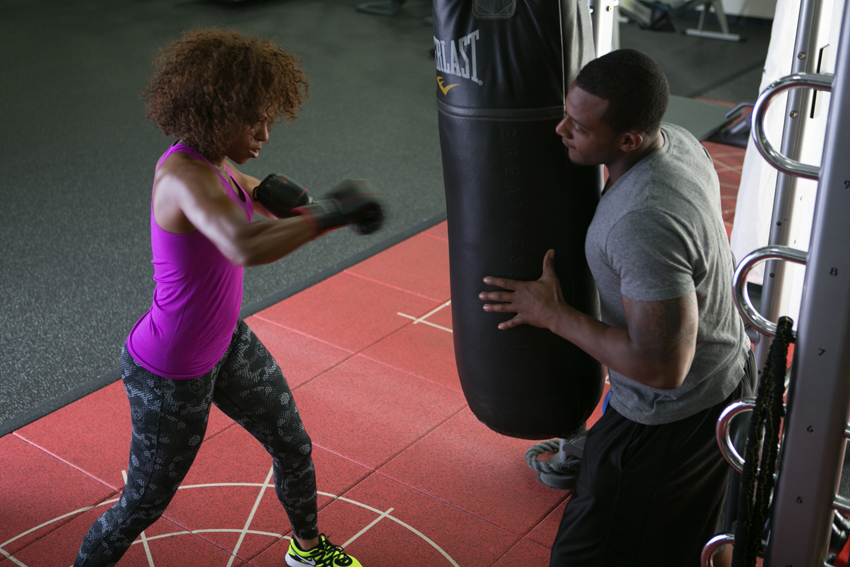
Different performance surfacing should be used in an athletic facility based upon space and the activities being performed there.
Recommended Performance Surfaces for the Most Common Sports, Fitness, and Recreation Applications
To determine the best performance floor to specify for a sports, fitness or recreation application, these issues should be considered:
- How the space will be used;
- Priorities for each space;
- Versatility needed;
- Design: color, texture, pattern, logos, and graphics;
- Durability; and
- Cleanability.
The following eight applications are the most popular among sports, fitness, and recreation facilities. In addition to identifying the recommended flooring characteristics for each application, we will also recommend the best flooring options.
Cardio/Sectorized Strength
In cardio and strength areas, noise and impacts from cardio machines and dropping of weight stacks can have a negative impact on those in adjacent areas. These areas need noise mitigating flooring. Energy restitution to mitigate indentations is also necessary.
Recommended flooring characteristics:
- Durable
- Cleanable
- Scuff and indent resistant
Flooring options:
- Good: LVT/vinyl
- Better: engineered vinyl or engineered vulcanized calendered rubber
- Best: engineered VCR
Functional Training Applications/Training Centers
Training centers are spaces dedicated to everything from strength and conditioning to martial arts, aerobics, and gymnastics. These spaces require safe and durable surfaces. The floor should be able to absorb the shock of running and jumping to protect athletes’ joints; falls also may be a concern. VCR offers one of the safest flooring options available for these conditions.
Recommended flooring characteristics:
- Durable (free weights and accessories are prevalent)
- High coefficient of friction (wet and dry)
Flooring options:
- Good: 8-millimeter/1⁄4 -inch composition rubber
- Better: composition rubber with Class 1 in force reduction
- Best: 14-millimeter or more composition rubber with Class II in force reduction
Free Weight Areas and Olympic Lifting Areas
Weight rooms are specialized training areas that must have an especially durable surface capable of supporting the heavy impact of weight-training and cardio equipment. Ultra-thick composition rubber molded tiles or multilayer engineered rubber surfaces are ideal choices for weight rooms because VCR provides superior durability and shock absorption. Moreover, if tiles are installed and an area is damaged or wears out, individual tiles can be replaced without the expense of the whole floor.
Recommended flooring characteristics:
- Durable
- Slip resistant
- Scruff and indent resistant
- Substrate crack suppression
Flooring options:
- Good: 8-millimeter/1⁄4 -inch VCR
- Better: 1-inch molded tile/10- to 15-millimeter high-density rolled VCR
- Best: 20-millimeter or more dual durometer (a measure of hardness) rolled VCR
Indoor Courts
Indoor courts require a firm surface and an even density so every part of the playing surface responds with a consistent and energetic ball bounce. Vinyl surfacing that is fusion bonded to a VCR backing provides exceptional safety and performance for athletes on indoor courts by providing outstanding ball bounce while still providing good area elasticity to prevent impact injuries. The ideal flooring also allows better foot slide than many resilient surfaces, an important feature for fast-moving sports where a high coefficient of friction can lead to foot/knee-overturn injuries. This type of surfacing is durable and easy to install and maintain.
Recommended flooring characteristics:
- Consistency
- Superior foot slide
- Durable
- Scuff and indentation resistant
Flooring options:
- Good: solid or engineered wood
- Better: Class I for force-reduction synthetic court
- Best: Class I for force-reduction synthetic high-pressure laminate
Indoor Tracks
For tracks, runners need a surface that does not absorb a lot of energy, and yet is not so hard that it will cause shin splints and other stress syndromes associated with running on hard surfaces. A dense engineered VCR surface provides an optimal choice for many indoor track applications.
Recommended flooring characteristics:
- Durable
- Cleanable
- Scuff and indent resistant
Flooring options:
- Good: pad and pour (urethane)
- Better: poured-in-place rubber
- Best: engineered rubber sheet with shock-absorbing underlayment
Indoor Turf Fields
Synthetic turf with a VCR backing works well on indoor fields for competitive hockey, lacrosse, and soccer as well as for indoor sports training facilities. The wear layer should be durable enough for heavy-training activities, such as football conditioning using speed drags and blocking sleds, as well as spike resistant.
Recommended flooring characteristics:
- Purpose (speed and agility, functional, and body weight training)
- Coefficient of friction
- Cleanable
Flooring options:
- Good: multipurpose slit film with infill
- Better: multipurpose non-infill system
- Best: turf fabric/non-infill system with shock-absorbing VCR underlayment
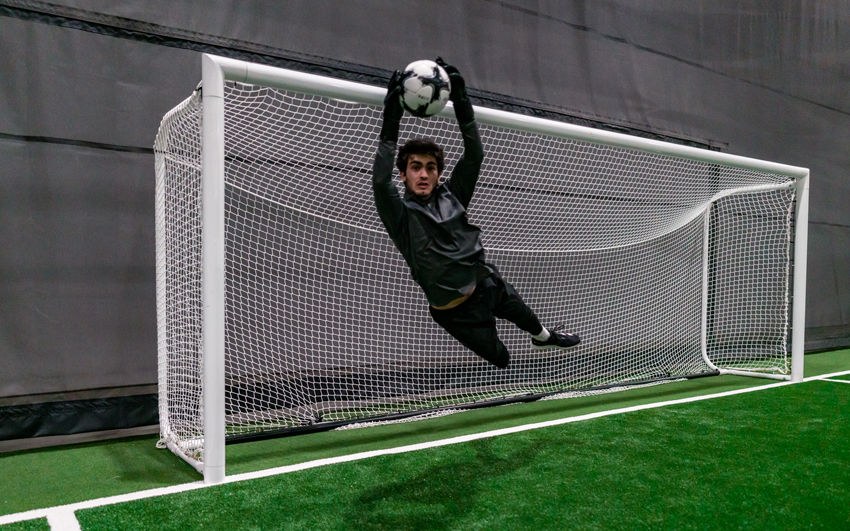
Synthetic turf with a VCR backing is durable enough for pushing sleds or using speed drags.
Group Fitness/Dance/Spin/Yoga/Exercise
Group exercise, dance, yoga, and spin rooms require both durability and resilience. The trend for these spaces is moving away from vinyl with a foam underlayment to an engineered vinyl with a VCR backing for better performance. These applications are also moving away from wood and opting for engineered vinyl with a VCR backing because it holds up better and requires less maintenance.
Recommended flooring characteristics:
- Nonporous
- Cleanable
- Seamless
- Durable (free weights and potential for bike cleats)
Flooring options:
- Good: luxury vinyl tile/sheet vinyl/wood
- Better: Class I sports floor
- Best: Class II sports floor
Note: The surface needs to pass all four criteria of ASTM F2772 to be considered a “sports floor” under this standard.
Bathrooms/Locker Rooms
Rather than being an afterthought, bathrooms and locker rooms are a major element of any fitness or recreation center. The ideal flooring will be easy to clean, resist microbial growth, and provide superior slip resistance to keep users safe.
Recommended flooring characteristics
- Nonporous/sanitary/antimicrobial
- Slip resistant
- Cleanable
- Welded seams/seamless floor
Flooring options:
- Good: ceramic/porcelain tile
- Better: vinyl or VCR sheet
- Best: seamless and slip-resistant VCR with Class 1 force reduction

The flooring for exercise rooms should be durable, seamless, and easily cleaned.
Case Studies
The following case studies illustrate how engineered performance flooring was specified to bring safety, ergonomic, and acoustic benefits to various sports, fitness, and recreation venues.
Case Study: COPA Athletic Training Facility
This case study illustrates an athletic application that features 11 different performance surfaces.
The 11,000-square-foot Comprehensive Objective Performance Assessment Soccer Training Center (known as COPA) was designed to analyze athletes from every angle to improve their cognitive, physical, and technical abilities. This elite soccer training center, which was built on the grounds of an old newspaper plant, is the latest addition to the Shadelands Sports Mall in Walnut Creek, California. CEO and Developer Mark Hall selected retired soccer player, fitness expert, and entertainer Andy McDermott to serve as COPA’s director of culture.
In his role, McDermott was tasked with overseeing many aspects of design and development of this state-of-the-art training center. The facility is the future home to a minor league professional soccer team in development and where many notable professional soccer athletes train. COPA uses data and analytics to take athletes of all ages to the next level. To do this, advanced methods are used, including pressure plates under the flooring to measure power and speed, biomechanical video analysis, dynamic movement skills, and other innovative technologies designed to enhance speed and performance.
Challenge
Retrofitting a multipurpose athletic facility into a building constructed more than four decades ago can be extremely daunting. The design challenges were compounded by the fact that COPA required numerous types of surfaces to support a variety of sports and fitness spaces. Eleven different surfaces
were required.
Solutions
Following the recommendation of a strength and conditioning coach, McDermott chose a U.S.-based company for all 11 surfaces. Each area of the COPA Soccer Training Center had unique requirements in the areas of safety, ergonomics, and acoustics.
Double Speed Court
The Double SpeedCourt provides coaching and training on foundational running and movement techniques. This enhanced training requires a surface that provides comfort for body contact points, like elbows and knees. The engineered turf specified uses a patented technology to fusion bond a durable, textured polyethylene wear layer to a 5-millimeter vulcanized composition rubber backing, making it suitable for functional fitness environments like the Double SpeedCourt.
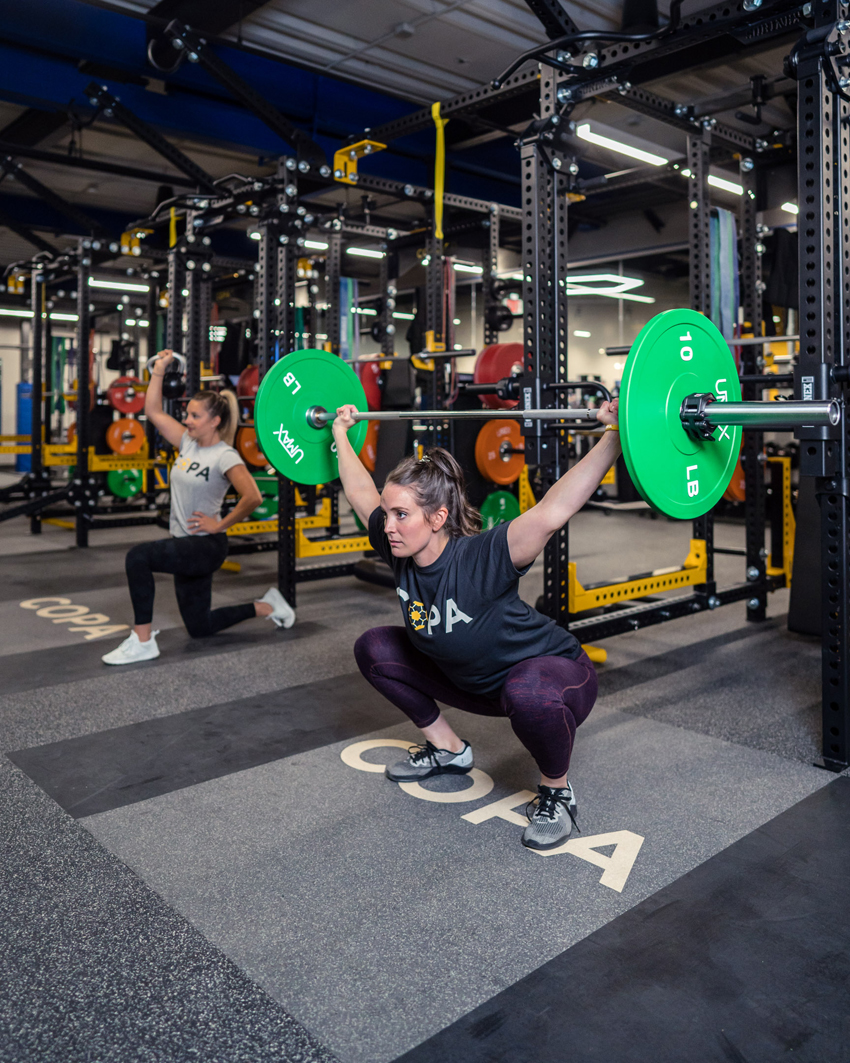
The COPA training center includes 11 different surfaces from the same U.S. athletic flooring manufacturer.
COPA Cube, Powergoal, Technique Studios, Mini Cube, and COPA Kids Jungle Field
A special high-pile turf was used in multiple areas of the COPA training center, including the COPA Cube. Designed by COPA Innovation Laboratories, this state-of-the-art space assesses a player’s ball control, passing ability, and decision-making. The turf was also specified in the Powergoal, Technique Studios, Mini Cube, and COPA Kids Jungle Field. The high-pile turf specified is a 37-millimeter system comprised of a 25-millimeter turf wear layer field united to a 12-millimeter VCR “shock pad” or underlayment (25 millimeters/12 millimeters). The thatch support system of this product eliminates the need for infill, making it ideal for indoor training turf.
Futsal Court, Spin Room, and Retail Spaces
COPA offers members 25,000 square feet of futsal courts, which are typically constructed from wood. COPA chose to use a more forgiving synthetic wood-grain vinyl surface that is fusion bonded to a 5-millimeter VCR backing. The result is flooring that looks like real wood but is more economical, durable, and easier to clean. This surface provides up to 60 percent force reduction for players’ safety and comfort. This surface was also installed in the spin room and retail spaces.
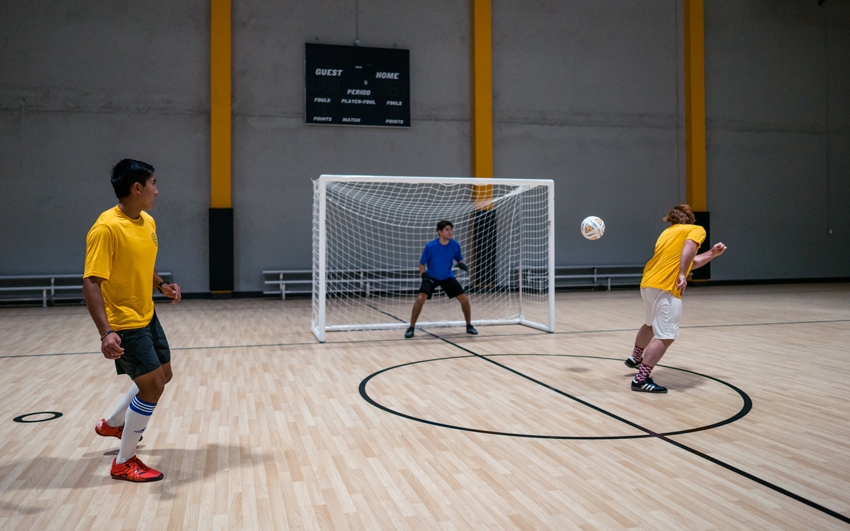
Indoor courts at the COPA training center look like real wood but are made out of vinyl with a VCR backing.
Indoor Turf Arena
Covering the indoor Turf Arena, a turf product was specified that offers a high pile that is quick and highly playable. This multipurpose field has the softness of grass in an indoor setting.
Weight Room
For the weight room between the circuit and sports performance areas is an advanced turf that features a dense, textured nylon wear layer fusion bonded through a patented technology to a vulcanized composition rubber backing. While too abrasive to fall or dive on, this consistent and tight surface is ideal for all footwork drills, battle ropes, sled work, and medicine balls.
Outdoor Track
Used for the COPA’s outdoor track is a wet-poured, one-layer, troweled-on-site rubberized surface system. It provides a high-quality sprinting track with optimum footing and is also appropriate for recreation and outdoor sports areas.
Weightlifting Area and Kids SpeedZone
Specified in the weightlifting area and COPA Kids SpeedZone is a rubber flooring custom made for extreme strength and conditioning. It is a 22.5-millimeter vulcanized composition rubber system that is then field united to a 12-millimeter underlayment in the field. The resulting system combines the durability and firm footing desired in strength training with the ergonomic demands of aggressive functional training in one surface. The flooring is both cushioning and sound absorbing. It was installed in five lifting rack areas with five lifting inlay platforms that seamlessly sport the COPA logo on the surface.
Speed Lab, Cardio Area, Indoor Track
In the Speed Lab, which was designed to teach and enhance running techniques and movement skills, a performance flooring was specified that is tailored for heavy conditioning. It is a 14.5-millimeter vulcanized composition rubber product with a 2.5-millimeter wear layer fusion bonded to a 12-millimeter shock-absorbing base layer to achieve a dynamic force reduction of 35.4 percent. This system is engineered to absorb the impact force related to aggressive functional training, providing an ergonomically advanced surface that works in concert with the body. It was also specified in the cardio area and indoor track.
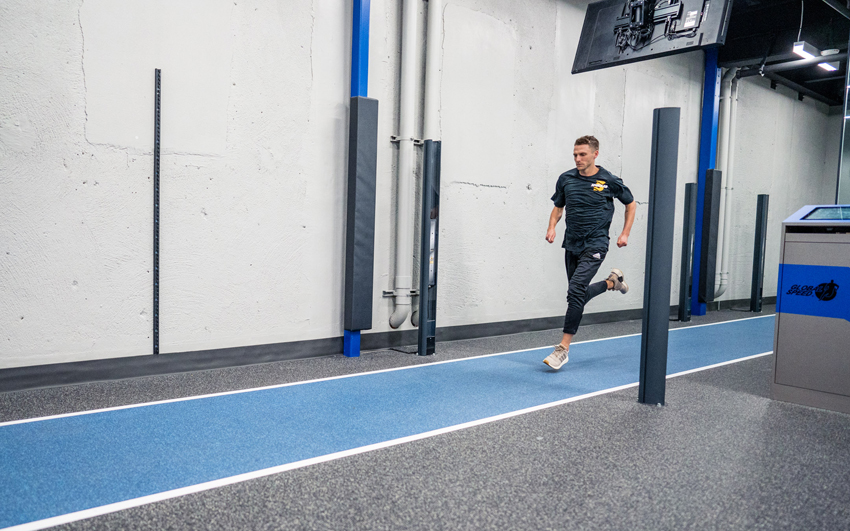
The flooring in the COPA Speed Lab is comprised of two layers of VCR that are fusion bonded together.
Shower Area
The COPA shower area required a slip-resistant, waterproof surface. The flooring specified is engineered with slip-resistant particles and a raised emboss for added stability.
Locker Rooms and Whirlpool Area
Used in the locker rooms and whirlpool area, a safety flooring with optimal traction provides an enhanced coefficient of friction to prevent falls in traffic areas where slipping may occur.
Results
Within six weeks of opening, COPA enrolled more than 1,000 members and featured visits from the U.S. Women’s National Team’s soccer stars Alex Morgan, Julie Ertz, and Allie Long. In addition, the men’s U.S. Futsal National Team paid a visit for some practice sessions and found the playing surface to be considerably better than the traditional wood flooring they were accustomed to using.
According to McDermott, who helped lead the project from concept to completion: “Rehabbing an old building involved multiple stages of construction, which meant balancing timing and orders. The flooring manufacturer did a great job coordinating and working around a crazy construction schedule to get the job done right the first time.”

Acoustics were a big concern at the East Bank Club in Chicago because a professional coworking space and cycle studio are above the free-weight room.
Case Study: East Bank Club, Chicago
The East Bank Club in Chicago is more than 450,000 square feet of space and covers more than two full city blocks. The premier health facility offers a variety of amenities, including state-of-the art exercise facilities and dining options. Users expect a high level of functionality at the facility, and so when it was time to choose surfacing in its free-weight room, the specification was considered carefully.
Challenge
Acoustics were a big concern in this space, because the East Bank Club is a multistory environment. “We had some challenges with designing our new free-weight room when it came to acoustics,” says Gretchen Collins, director of fitness at East Bank Club. “Our professional coworking space and cycle studio are directly above the free-weight room, and we have professional office spaces on the other side of the hallway. We had to be mindful that dropping weight would not impact the areas above, so we were looking for a product that could dampen sound and vibration.”
Solution
The solution was an advanced athletic flooring comprised of a 10.5-millimeter engineered roll field united, using a proprietary bonding process, to a 12-millimeter underlayment. The result is a 22.5-millimeter vulcanized composition rubber engineered system that provides ergonomic, safety, and acoustic benefits. Regarding ergonomics, the flooring has a force reduction (absorption of impact energy) of 38.1 percent and an energy restitution (useful return of impact energy) of 53.5 percent. It a safe floor because it is slip resistant and protects lifters from rebounding bar and weight drops.
Results
When it comes to acoustics, the engineered rubber flooring is an ideal solution for weightlifting applications because the surface can manage the energy of the impact of the weights hitting the floor.
The result is a quieter space.
“We tested a variety of products and found the product to be the best in regard to sound and vibration dampening,” Collins says. “We are extremely happy with the outcome of the space.”
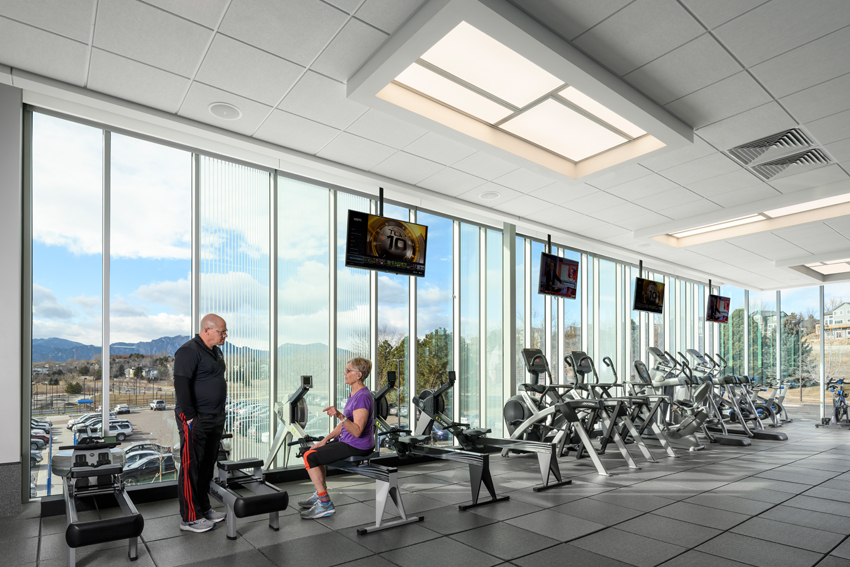
A large expansion of the Louisville Recreation and Senior Center called for a number of athletic flooring specifications that blended together into a coordinated design scheme.
Case Study: Louisville Recreation and Senior Center
When a $28-million expansion of the Louisville Recreation and Senior Center was being planned, the choice of new flooring for various applications was a major point of discussion.
Built in 1990, the center is a public hub for seniors, preschoolers, and fitness enthusiasts. It is dedicated to supporting physical, mental, and social wellness for the city’s residents, including providing services for members ranging from 3 months old to more than 100 years old.
“Our motto is ‘There is something for everyone’,” says Kathy Martin, superintendent of recreation and senior care services. “We are one of the busiest recreation centers in Colorado, and our mission is to provide opportunities for social engagement that supports both physical and mental well-being.”
As the community grew, so did the need for more space and equipment. Following a feasibility study in 2016, a major construction project took place and was completed in 2019.
Renovations included the addition of a second floor with a weight room and expanded cardio areas, a second lap pool, a leisure pool, a splash pad, a daycare facility, and indoor turf field and playground.
Challenge
The recreation center’s renovations also called for a first-floor daycare center, but design plans situated the cardio area and weight room directly above the daycare. Due to this layout, the design required flooring with high sound-mitigation properties to make these fitness areas less intrusive to the toddlers and staff below.
Additionally, the expanded pool space needed flooring that was extremely slip resistant for lifeguards, guests, and members.
In addition to meeting a variety of performance requirements, the flooring also needed to support way finding and the aesthetic vision of the design team.
“We had to be sure we satisfied the needs of the community while also adhering to performance and safety requirements,” says Miranda Dooley, interior designer III, Perkins and Will.
Solution
The massive expansion required a variety of surfaces with enhanced acoustic, slip-resistant, and low-maintenance properties. Having worked with the flooring manufacturer on previous construction projects, Perkins and Will specified the company’s flooring for the needs of the center.
In the weight room, an engineered rubber flooring was selected for its extreme durability and superior sound mitigation. The surface diminishes shock by absorbing the impact from weights being released onto it. The large installation of more than 1,200 linear feet of engineered rubber flooring required collaboration between the designers and the company.
Installed in the cardio area was a multilayer surface that features a proprietary technology that balances the distribution of force reduction and energy restitution, resulting in less impact on knees and joints of runners and walkers. Engineered rubber roles and tiles were used in areas such a hallways and circuit training zones that required a durable, affordable surface. Finally, a vinyl safety flooring engineered with slip-resistant particles and a raised embossment for added slip resistance was installed in the pool area.
Results
The newly renovated 103,000-square-foot recreation center serves as a centerpiece of the Louisville community, offering a wide range of amenities and activities. The lifeguard staff appreciates the high slip-resistant properties of the safety surface around the pool, in changing rooms, and in the pool party area.
In addition, cardio and weight areas with sound-mitigating properties are not disruptive to the preschool rooms below.
“I have no doubts in the performance of this flooring,” Dooley says. “The flooring company was able to mix the specifications we needed for a wide variety of activities while incorporating congruent finish options, making it look like one seamless application.”
Conclusion
As we have seen, flooring choices for sports, fitness, and recreation applications go way beyond price and color. The stakes are high in facilities where weights are lifted and dropped, where bodies are stressed to their limits, and where wellness is the goal. The COVID-19 pandemic made clear that physical wellness may be critical for survival, and the fitness and wellness industries are booming.
Architects, designers, project managers, and other specifiers need to be well-versed in the benefits that advanced performance flooring can bring in terms of safety, ergonomics, and acoustics. With the right flooring, everyone using the facility can be given their best chance to advance their own fitness with more safety, less bodily stress, and better acoustics. The flooring specification can make a world of difference.
End Notes
1“Sports Equipment Market Analysis Report By Product (Ball Games, Ball Over Net Games, Fitness/Strength Equipment, Athletic Training Equipment), By Distribution Channel, And Segment Forecasts, 2018–2025.” Grand View Research. July 2018. Web. 7 April 2021.
2”Safety Tips: Sports.” Safe Kids Worldwide. Web. 7 April 2021.
3”Safety Tips: Falls.” Safe Kids Worldwide. Web. 7 April 2021.
Kathy Price-Robinson writes about building and design. Her remodeling series “Pardon Our Dust” ran 12 years in the Los Angeles Times. She specializes in buildings that are durable and resilient to climate disruptions, as well as products and designs that provide shade in hot climates. www.kathyprice.com















